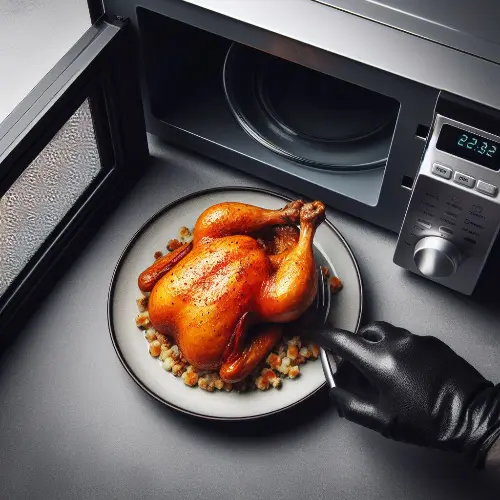Thekitchenkits.online is an Amazon Associate and earns from qualifying purchases made through affiliate links on our site at no extra cost to you. This supports our efforts to bring you valuable kitchen-related content.
Table of Contents
Why Does Microwave Chicken Taste Bad
Chicken that is reheated in the microwave often develops an unappealing flavor and texture, leaving many to wonder why microwaved chicken tastes bad. The main culprit behind the poor taste of reheated chicken is a phenomenon known as “warmed-over flavor“.
What is Warmed-Over Flavor?
Warmed-over flavor (WOF) is the name given to the undesirable flavors that can develop when cooked meats, especially chicken, are reheated. It’s characterized by a stale, cardboard-like taste and smell. While not dangerous to eat, warmed-over chicken is unpalatable to most.
The warmed-over flavor is most noticeable in chicken and other white meats like turkey, though it can also occur in beef, pork, and fish. The chicken breast is particularly susceptible since it contains high levels of polyunsaturated fatty acids, which are vulnerable to oxidation.
Why Does Warmed-Over Flavor Develop?
The warmed-over flavor is the result of a series of chemical reactions that take place when cooked meat is exposed to oxygen. During cooking, complex molecules within the meat break down, releasing iron and other free ions. When the cooked meat is refrigerated, these particles catalyze oxidation reactions with the polyunsaturated fatty acids.
These oxidation reactions produce breakdown products like aldehydes, ketones, and other volatile compounds. It is these chemical byproducts that give warmed-over meats their characteristic stale, rancid taste and smell.
Why Does Microwaved Chicken Get Warmed-Over Flavor So Easily?
There are a few reasons why chicken reheated in the microwave is especially prone to warmed-over flavor:
- Dry, uneven heating: Microwaves often dry out chicken, increasing oxidation reactions. Hot spots lead to overcooked sections.
- No browning: The Maillard reaction and caramelization that occurs when meats are roasted, grilled, or fried improve flavor. Microwaves don’t produce this.
- Shorter reheating time: Longer, slower reheating helps keep moisture and prevents drying out.
- No barriers to air: Wrapping or sauce barriers aren’t used as often for microwave reheating.
For best results, chicken should be reheated using a method other than the microwave, such as oven-heating, or kept immersed in a sauce or gravy during microwave reheating.
How to Prevent Warmed-Over Flavor When Reheating Chicken
Here are some tips to keep that reheated chicken tasting delicious:
- Refrigerate cooked chicken properly within 1-2 hours of cooking, and reheat within 3-4 days.
- Store cooked chicken in an airtight container to prevent oxygen exposure.
- Cook chicken to a safe internal temperature when initially cooking to avoid undercooking when reheating.
- When reheating, use an oven, skillet, or toaster oven to prevent drying out.
- Microwave chicken immersed in a sauce, gravy, or chicken broth.
- Reheat the chicken slowly on lower microwave power.
- Add antioxidants like lemon juice, rosemary, and oregano when initially cooking.
- Avoid reheating chicken more than once. Cook only what you will consume.
- For fried chicken or chicken wings, reheat in the oven until crispy.
FAQs
Why does leftover microwave chicken taste bad?
Leftover microwave chicken can taste bad due to a phenomenon known as “warmed-over flavor” (WOF). When cooked chicken is exposed to air and then reheated in a microwave, the flavor of the meat can deteriorate, resulting in a bad taste.
How can I prevent leftover chicken from tasting bad?
To prevent leftover chicken from tasting bad, there are a few ways you can try. First, when cooking chicken, opt for chicken thighs instead of breast meat. Thighs are less likely to dry out when reheated. You can also try reheating fried chicken in a fryer or oven instead of a microwave, as this can help maintain its crispy texture and flavor.
Additionally, consider utilizing the chicken to make dishes such as chicken curry, as the added spices and flavors can mask any unpleasant taste. Lastly, storing the leftover chicken properly in an airtight container in the refrigerator can help minimize contact with air and prevent the development of a bad taste.
What is “warmed-over flavor” or WOF?
“Warmed-over flavor” refers to the taste that develops in leftover cooked meat when it is reheated or exposed to oxygen. It is characterized by a rancid or metallic taste and can make the meat less appetizing. Food scientists have studied this phenomenon and it is known to be more pronounced in poultry, such as chicken.
Why is reheated fried chicken susceptible to the warmed-over flavor?
Reheated fried chicken can be particularly susceptible to the warmed-over flavor due to its exposure to oxygen during the cooking and reheating process. As the chicken is fried and then reheated, the unsaturated fats in the meat can oxidize, resulting in the development of a bad taste.
What is the best way to reheat fried chicken without compromising its taste?
The best way to reheat fried chicken without compromising its taste is by using a fryer or an oven instead of a microwave. Reheating the chicken in a fryer or oven helps to maintain its crispy texture and prevents the development of the warmed-over flavor. It is recommended to reheat the chicken at a low temperature, around 325°F (163°C), and use a thermometer to ensure it reaches a safe internal temperature of 165°F (74°C).
Can flavor be added to the chicken to mask any bad taste?
Yes, flavor can be added to the chicken to help mask any bad taste. One way to do this is by using marinades or rubs before cooking the chicken. These can add extra flavors and enhance the overall taste of the meat. Additionally, using the chicken to make dishes such as chicken curry or incorporating it into other flavorful recipes can help enhance the taste and override any unpleasant flavors that may have developed during reheating.
Are there any other ways to make chicken taste better after reheating?
Yes, there are other ways to make chicken taste better after reheating. Sous vide cooking is one method that can help retain the chicken’s moisture and flavor.
By vacuum-sealing the chicken and cooking it in a temperature-controlled water bath, the meat can be reheated evenly and without losing its original taste. This technique is often used by professional chefs and can result in a tender and flavorful chicken after reheating.
How does exposure to oxygen affect the flavor of the chicken?
When chicken is exposed to oxygen, the unsaturated fats in the meat can oxidize. This oxidation process can lead to the development of off-flavors and contribute to the bad taste often associated with reheated leftovers.
Properly storing the chicken in an airtight container and minimizing its contact with air can help prevent or reduce the flavor deterioration caused by oxygen exposure.
Is it safe to eat microwave chicken even if it tastes bad?
If microwave chicken tastes bad, it is recommended to exercise caution and consider not consuming it. While the bad taste may not necessarily indicate that the chicken is unsafe to eat, it is always best to prioritize food safety. If in doubt, it is advisable to discard the chicken and opt for freshly prepared alternatives.
How can I prevent cooked chicken from becoming rubbery when reheated?
To prevent cooked chicken from becoming rubbery when reheated, it is important to avoid overheating or overcooking the meat. Overheating can cause the proteins in the chicken to tighten and become tough and rubbery. Using lower temperatures and shorter reheating times can help prevent this. Additionally, adding some moisture to the chicken before reheating, such as a splash of broth or a drizzle of sauce, can help prevent drying and maintain the chicken’s juiciness during reheating.
Conclusion
The development of unpleasant warmed-over flavors and textures is a common issue when reheating chicken in the microwave.
To prevent your leftover chicken from tasting bad, limit oxidation by properly storing cooked chicken, reheating it gently using preferred methods like the oven, and keeping exposure to air and multiple reheating to a minimum.
With some simple tweaks to your reheating method, you can enjoy delicious leftover chicken meals.

I’m Ian Welkins, a seasoned professional in the kitchen industry. My passion now drives me to provide invaluable insights into the world of top-notch kitchen products. With years of hands-on experience, I’m your go-to source for culinary excellence.


